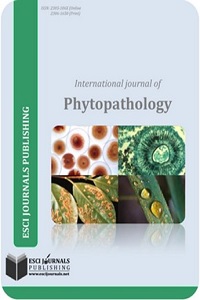Pathogenic variation of colletotrichum lindemuthianum causing anthracnose of beans (phaseolus vulgaris) in Uganda
Colletotrichum lindemuthianum is a highly variable pathogen of common beans that easily overcomes resistance in cultivars bred with single-gene resistance. To determine pathogenic variability of the pathogen in Uganda, samples of common bean tissues with anthracnose symptoms were collected in eight districts of Uganda, namely Kabarole, Sironko, Mbale, Oyam, Lira, Kapchorwa, Maracha and Kisoro. 51 isolates sporulated successfully on Potato Dextrose Agar and Mathur’s media and were used to inoculate 12 differential cultivars under controlled conditions. Five plants per cultivar were inoculated with each isolate and then evaluated for their reaction using the 1 – 9 severity scale. Races were classified using the binary nomenclature system proposed by Pastor Corrales (1991). Variation due to cultivar and isolate effects was significant (P≤0.001) for severity. The 51 isolates from eight districts grouped into 27 different races. Sironko district had the highest number of races followed by Mbale and Kabarole. Races 2047 and 4095 were the most frequently found, each with 10 isolates grouped under them. Race 4095 was the most virulent since it caused a susceptible (S) reaction on all 12 differential cultivars and the susceptible check. This was followed by races 2479, 2047 and 2045 respectively. Two races, 4094 and 2479, caused a susceptible reaction on the differential cultivar G2333, which nevertheless, showed the most broad spectrum resistance followed by cultivars Cornell 49-242, TU, and AB136 respectively. These cultivars are recommended for use in breeding programs aiming at breeding for broad spectrum resistance to bean anthracnose in Uganda.

